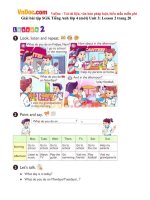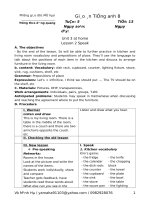UNIT 3 LESSON 2 PART 1 vocabulary and reading
Bạn đang xem bản rút gọn của tài liệu. Xem và tải ngay bản đầy đủ của tài liệu tại đây (137.29 KB, 4 trang )
Date of preparing:
Date of teaching:
………………………………….
………………………………….
Period……
UNIT 3: FRIENDS
Lesson 2 - Part 1 (Page 25) - Vocabulary and Reading
I. OBJECTIVES
By the end of the lesson, Ss will be able to…
1. Knowledge
- know more vocabularies that can go with “go”, “play”, “have”, “watch” and “make”.
- invite someone to do an activity.
2. Ability
- improve the use of English and Reading skills.
3. Quality
- have positive attitude in English language learning so that they actively participate in all classroom activities.
- relax after hard working time at school.
II. TEACHING AIDS AND LEARNING MATERIALS
Lesson plan, PPT slides, student’s book, workbook, notebook, personal computer (if any), projector/TV,
speakers, DCR & DHA on Eduhome, handouts...
III. PROCEDURES
A. Warm up: (5’)
a) Objective: Introduce the new lesson and set the scene for Ss to acquire new language; get students'
attention at the beginning of the class by means of enjoyable and short activities as well as to engage them in
the steps that follow.
b) Content: Introduction of some after school activities.
c) Product: Ss know more activities they are going to study in the lesson.
d) Competence: Collaboration, creativity, communication.
e) Organization of the activity:
Teacher’s Activities
- Give greetings
- Check attendance
Option 1: Game: Acting
- Invite 1 or 2 Ss who will be the actor to stand in front of the
class.
- Give this / these students a small piece of paper with a verb
phrase inside.
- Have this / these students act (use body language) to
demonstrate the activity
- Have the rest of the class guess what the verb phrase is
- Have Ss give a big applause to the Ss who have the right
Students’ Activities
- Greet T
- Volunteer to be the actor
- Read and act
- Guess the activity
- Listen
answer
- Give feedback and lead to the new lesson.
*Verb phrases: go shopping, play badminton, watch a
movie, have a party, make a pizza
Option 2: Network of words
- Give Ss 2 key words: “Play” and “Go”
- Have Ss find out as many as possible words that can go
after “play” and “go”
- Have Ss give answers
- Check the accuracy, spelling
Lead to the new lesson
- Work in groups
- Write answers
Suggested answers
Play: badminton, soccer, football, volleyball,
basketball, video games, chess, …
Go: shopping, fishing, dancing, hiking, …
B. New lesson (36’)
Activities 1: Vocabulary (17’)
a) Objective: Ss know more vocabularies that can go with “go”, “play”, “have”, “watch” and “make”
b) Content:
- Filling in the table
- Adding more words to the table
c) Products: Ss know how to pronounce the new words correctly and use them in appropriate situations.
d) Competence: Communication, collaboration, presentation, listening, creativity.
e) Organization of the activity:
Teacher’s Activities
a. Fill in the table. Listen and repeat.
- Demonstrate the activity, using the example in the book.
- Have Ss fill in the table
- Ask Ss to work in pairs to check their answers with their
partners.
- Check answers as a whole class.
- Play the audio (CD1 – Track 34) for Ss to listen and
repeat.
- Call some Ss to read the phrases again, correct their
pronunciation and stress.
b. Add more words to the table
Option 1:
- Have pairs add more words to the table
- Call Ss to share answers with the class
Students’ Activities
- Look and listen
- Work in pairs
- Listen and check
- Listen and repeat
- Read
Answer keys
1. Go: shopping, swimming, to the beach, to the
mall
2. Play: badminton, video games
3. Have: a party, a pizza, a barbecue, a cake
4. Watch: TV
5. Make: a pizza, a cake, a movie
- Work in pairs
- Give answers (Say or write on the board)
Suggested answers
1. Go: to school, to the movies, sailing, for a walk, …
2. Play: ping-pong, tennis, chess, board games, …
3. Have: a talk, a meeting, a headache, …
4. Watch: a movie / a film, a football match, …
5. Make: an appointment, breakfast, dinner, a mistake,
…
- Work in pairs
Option 2: (For class with low-level students)
- Give a set of words, ask Ss to put them in the right
column.
- Have Ss do the task in pairs
- Call Ss to give answers
- Check answers
- Give answers
.
Activity 2: Reading (19’)
a) Objective: Ss can develop their reading skills in different types of text
b) Content: Reading the messages and filling in the blanks
c) Products: Ss can complete the task successfully and enhance their reading skills.
d) Competence: Collaboration, communication, analytical and synthesizing skills.
e) Organization of the activity:
Teacher’s Activities
Read the messages and fill in the blanks with the
words from New Words (Vocabulary)
Option 1:
- Demonstrate the activity
- Have Ss read the messages and fill in the blanks using
the correct form of verbs from New Words. (Remind Ss
to use the Present Continuous)
- Have Ss work in pairs to check answers with their
partners
- Have some Ss share their answers with the class
- Give feedback
Option 2: (For class with better students)
- Follow the same steps as option 1
- Give an extra activity:
- Have Ss work in groups and make similar messages,
using their own ideas to make the messages more
interesting.
- Have Ss prepare the messages by writing them down on
Students’ Activities
- Read and fill in the blanks
- Check answers with partners
- Write answers
Answer keys
1. having
2. going
3. going
4. playing
- Work in groups
- Write on a piece of paper
a paper (format: text messages in a phone); then have
them use cell phone to send messages to another member
in the group. (Encourage Ss to use some popular messing
apps like facebook messenger or zalo)
- Remind Ss to use the Present Continuous and the words
/ phrases in New Words.
- Have Ss share their work with the whole class.
(T can have Ss capture the screen, then show them on the
TV or projector screen to check as a whole class)
- Check, give feedback and evaluation
- Send messages
- Show answers
Suggested messages
C. Consolidation (2’)
* Collocation:
1. Go: to school, to the movies, sailing, for a walk, …
2. Play: ping-pong, tennis, chess, board games, …
3. Have: a talk, a meeting, a headache, …
4. Watch: a movie / a film, a football match, …
* Invitation:
1. Do you want to come? / Would you like to come?
2. Come to my house
D. Homework (2’)
- Learn by heart the collocation.
- Make sentences with collocation with “go”, have”, “watch”, “play” and “make”.
- Do exercises in Workbook: Lesson 2 - New words – Part a and b (page 16).
- Prepare: Lesson 2 – Grammar (page 26 – SB).









